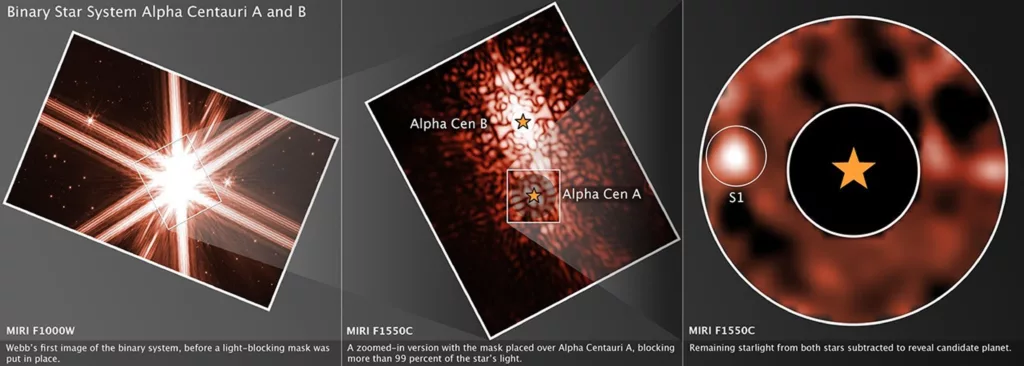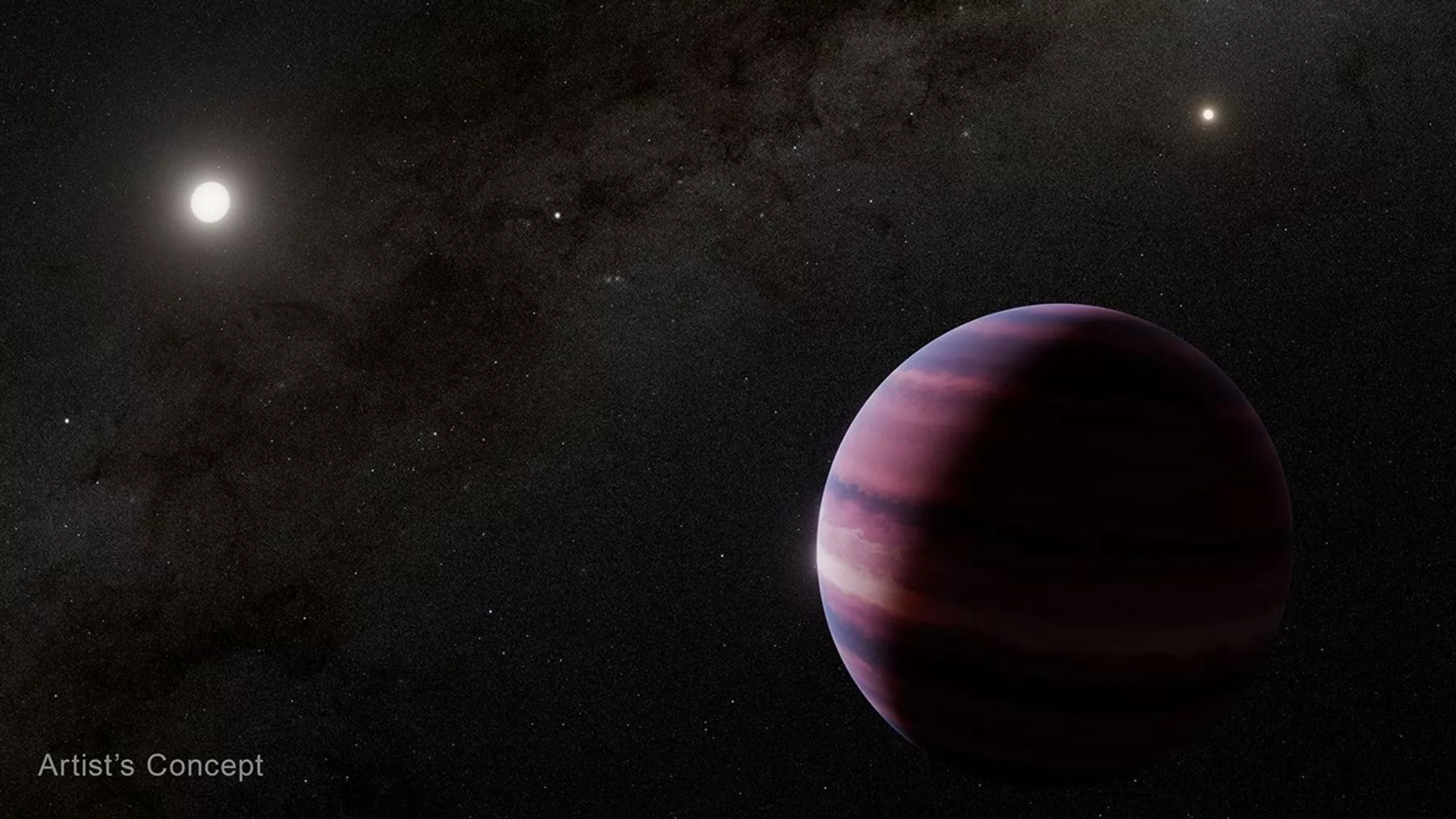Astronomers using NASA’s James Webb Space Telescope have found strong signs of a giant planet orbiting a star in the Alpha Centauri system, the closest stellar neighborhood to our Sun, just 4 light-years away!
Alpha Centauri is a trio of stars: Alpha Centauri A (super bright), Alpha Centauri B (its twin), and Proxima Centauri (a faint red dwarf).
We already know Proxima has three planets. But spotting worlds around the brighter stars has been tricky, until now.
Thanks to Webb’s Mid-Infrared Instrument (MIRI), scientists now have the best evidence yet of a gas giant orbiting Alpha Centauri A.
Jupiter-like cloud bands detected on closest known brown dwarf
If confirmed, this planet would be the closest one to Earth orbiting in the habitable zone of a Sun-like star, a region where temperatures could allow liquid water. Sounds promising, right?
But here’s the twist: It’s a gas giant, like Jupiter or Saturn. That means it’s made mostly of gas, with no solid surface, so it wouldn’t support life as we know it.
Charles Beichman, NASA’s Jet Propulsion Laboratory and the NASA Exoplanet Science Institute at Caltech’s IPAC astronomy center, co-first author on the new papers, said, “With this system being so close to us, any exoplanets found would offer our best opportunity to collect data on planetary systems other than our own. Yet, these are incredibly challenging observations to make, even with the world’s most powerful space telescope, because these stars are so bright, close, and move across the sky quickly.”
“Webb was designed and optimized to find the most distant galaxies in the universe. The operations team at the Space Telescope Science Institute had to come up with a custom observing sequence just for this target, and their extra effort paid off spectacularly.”

Science: NASA, ESA, CSA, STScI, DSS, A. Sanghi (Caltech), C. Beichman (NExScI, NASA/JPL-Caltech), D. Mawet (Caltech); Image Processing: J. DePasquale (STScI)
Finding a faint planet next to a blazing star isn’t easy, but the James Webb Space Telescope pulled it off with some clever tricks and serious teamwork. In August 2024, astronomers used the James Webb Space Telescope’s MIRI coronagraph to block the intense light from Alpha Centauri A, allowing them to peer more clearly into the surrounding space.
To refine their view, they carefully subtracted the light from both Alpha Centauri A and its nearby companion, Alpha Centauri B. Then, through extensive computer modeling, they ruled out other possible explanations for the faint object they detected, such as a distant galaxy, a passing asteroid, or an image artifact, strengthening the case that the source is likely a planet.
They found a mysterious object, 10,000 times fainter than Alpha Centauri A, sitting about twice the Earth–Sun distance away from the star.
Although the initial detection in August 2024 was thrilling, the research team needed more data to confirm the planet’s existence. Follow-up observations in February and April 2025, granted through Director’s Discretionary Time, did not reveal any trace of the object seen earlier.
PhD student Aniket Sanghi of Caltech in Pasadena, California, said, “We are faced with the case of a disappearing planet! To investigate this mystery, we used computer models to simulate millions of potential orbits, incorporating the knowledge gained when we saw the planet, as well as when we did not.”
To unravel the mystery, the researchers ran millions of computer simulations, factoring in the August detection, the absence of sightings in later months, and even a 2019 observation by the European Southern Observatory’s Very Large Telescope.
They modeled orbits that would remain gravitationally stable despite the influence of Alpha Centauri B, ensuring the planet wouldn’t be ejected from the system. Interestingly, the team found that in about half of the simulated scenarios, the planet’s orbit brought it too close to its star to be visible to Webb during the February and April observations, making the non-detection not just plausible, but expected.
Drawing from the planet’s mid-infrared brightness and orbital simulations, researchers believe it could be a gas giant with a mass similar to Saturn, orbiting Alpha Centauri A in an elliptical path that ranges between one and two times the Earth–Sun distance.


Science: NASA, ESA, CSA, STScI, A. Sanghi (Caltech), C. Beichman (NExScI, NASA/JPL-Caltech), D. Mawet (Caltech); Image Processing: J. DePasquale (STScI)
“If confirmed, the potential planet seen in the Webb image of Alpha Centauri A would mark a new milestone for exoplanet imaging efforts,” Sanghi says. “Of all the directly imaged planets, this would be the closest to its star seen so far. It’s also the most similar in temperature and age to the giant planets in our solar system, and nearest to our home, Earth.
“Its very existence in a system of two closely separated stars would challenge our understanding of how planets form, survive, and evolve in chaotic environments.”
If future observations confirm its existence, this planet could become a cornerstone for exoplanet research, offering rich opportunities for detailed study with Webb and other telescopes. NASA’s upcoming Nancy Grace Roman Space Telescope, launching by May 2027 (or possibly as early as fall 2026), will bring new tools to observe binary systems like Alpha Centauri. Roman’s visible-light data would complement Webb’s infrared insights, helping scientists better understand the planet’s size and reflectivity.
As the world’s leading space science observatory, Webb continues to unlock cosmic mysteries, from our solar system to distant exoplanets, revealing the hidden architecture of the universe and our place within it.
The results have been accepted in a series of two papers in The Astrophysical Journal Letters.
